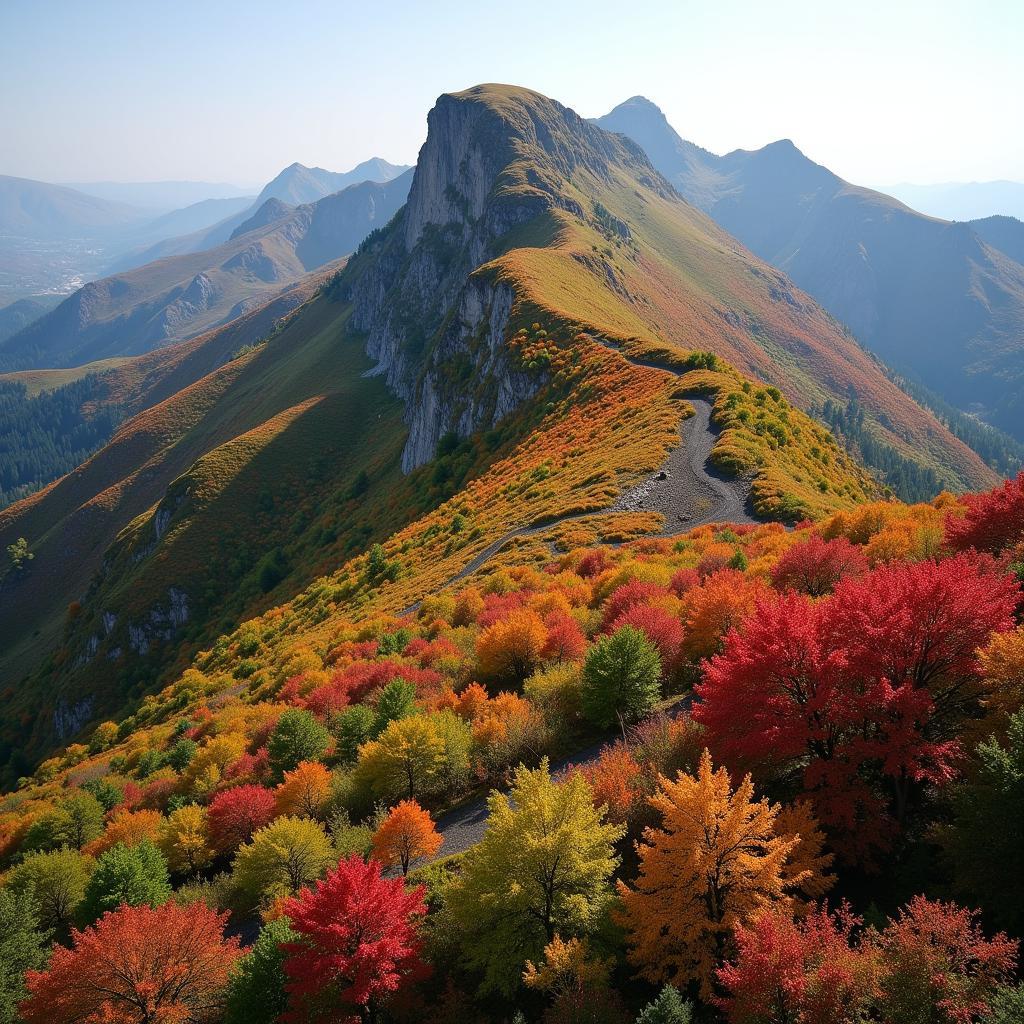Mountains, those majestic giants that pierce the sky, often appear as a singular, uniform color from afar. But a closer look reveals a captivating tapestry of hues, influenced by a myriad of factors. The perceived color of a mountain is not a fixed attribute, but rather a dynamic interplay of light, geology, vegetation, and even the time of day.
So, what is the color of a mountain? The answer is: it depends. While we often associate mountains with shades of brown, gray, or green, they can surprise us with vibrant splashes of red, purple, and even blue. Understanding the reasons behind these diverse color palettes adds another layer of appreciation to these natural wonders.
The Geology of Mountain Color
The underlying rock composition plays a crucial role in a mountain’s color. Granite, a common igneous rock, often lends a light gray or pinkish hue. Sandstone, composed of compressed sand, can range from beige to deep red, depending on the presence of iron oxide.  Mountain Rock Formations and Color Variations Mountains rich in limestone, a sedimentary rock, often exhibit a pale gray or white appearance. Shale, another sedimentary rock, can contribute darker grays and even black to the mountain’s palette.
Mountain Rock Formations and Color Variations Mountains rich in limestone, a sedimentary rock, often exhibit a pale gray or white appearance. Shale, another sedimentary rock, can contribute darker grays and even black to the mountain’s palette.
The Role of Vegetation
Vegetation significantly impacts the overall color of a mountain, particularly in lower elevations. Lush green forests drape the slopes, creating vibrant contrasts against the rocky surfaces. In autumn, these same slopes explode into a fiery mosaic of reds, oranges, and yellows as deciduous trees prepare for winter.  Mountain Vegetation and Seasonal Color Changes At higher altitudes, where conditions are harsher, vegetation becomes sparser, revealing more of the bare rock beneath. This transition creates a fascinating gradient of color, from the verdant foothills to the stark, rocky peaks.
Mountain Vegetation and Seasonal Color Changes At higher altitudes, where conditions are harsher, vegetation becomes sparser, revealing more of the bare rock beneath. This transition creates a fascinating gradient of color, from the verdant foothills to the stark, rocky peaks.
The Influence of Light and Atmosphere
Light and atmospheric conditions dramatically affect how we perceive a mountain’s color. The angle of the sun, the amount of cloud cover, and even the presence of dust or haze in the air can alter the perceived hues. At sunrise and sunset, the low angle of the sun bathes the mountains in warm, golden light, enhancing the reds and oranges. On cloudy days, the colors may appear muted and subdued. Furthermore, the phenomenon of atmospheric perspective can make distant mountains appear bluer due to the scattering of light. This is why [what color are the mountains] is such a complex question.
What Are the 5 Major Mountain Ranges in Colorado?
Colorado, a state renowned for its stunning mountain scenery, boasts several impressive ranges. Knowing the geological makeup of these ranges can provide clues about their color profiles. For instance, the San Juan Mountains, known for their volcanic origins, often exhibit darker, more dramatic hues. [what are the 5 major mountain ranges in colorado] provides a deeper understanding of the geological diversity within the state and its influence on mountain color.
The Illusion of Color
Sometimes, what we perceive as the color of a mountain can be an illusion. Shadows cast by clouds or adjacent peaks can create darker areas, giving the impression of variations in color. Similarly, snow and ice can dramatically alter the appearance of a mountain, cloaking it in a pristine white blanket.
Conclusion
So, what is the color of a mountain? It’s a complex question with a multitude of answers. The color of a mountain is not static but rather a dynamic interplay of geological composition, vegetation, light, and atmospheric conditions. By understanding these factors, we can move beyond a simplistic view and appreciate the rich tapestry of colors that adorn these majestic landscapes. For those interested in learning more, explore the fascinating world of mountain lion eye color in [what color are mountain lion eyes at night].
FAQ
- Why do mountains look blue from afar? This is due to atmospheric perspective, where air particles scatter blue light more than other colors.
- What makes some mountains red? The presence of iron oxide in rocks like sandstone can create red hues.
- Do mountains change color with the seasons? Yes, vegetation significantly impacts the color, changing from green to vibrant autumn hues.
- Why do mountains look different colors at sunrise and sunset? The low angle of the sun enhances warm colors like red and orange.
- What is the most common color of a mountain? Shades of gray and brown are commonly seen due to the prevalence of rocks like granite and sandstone.
- Can mountains be purple? Yes, at certain times of day, the interplay of light and atmosphere can create a purple hue.
- How does the rock type affect a mountain’s color? Different rock types have different mineral compositions, leading to variations in color.
When you need support, please contact us at Phone Number: 0373298888, Email: [email protected] or visit our address: 86 Cau Giay, Hanoi. We have a 24/7 customer service team.
